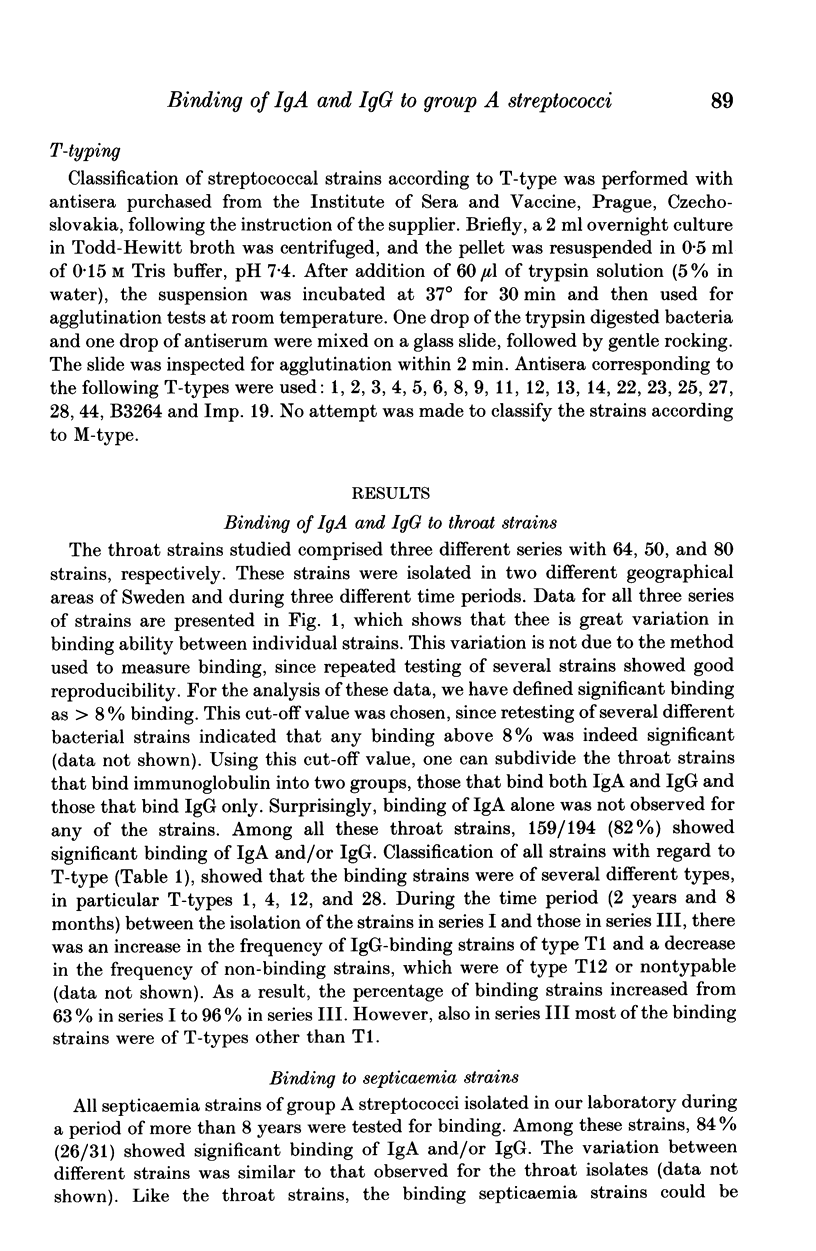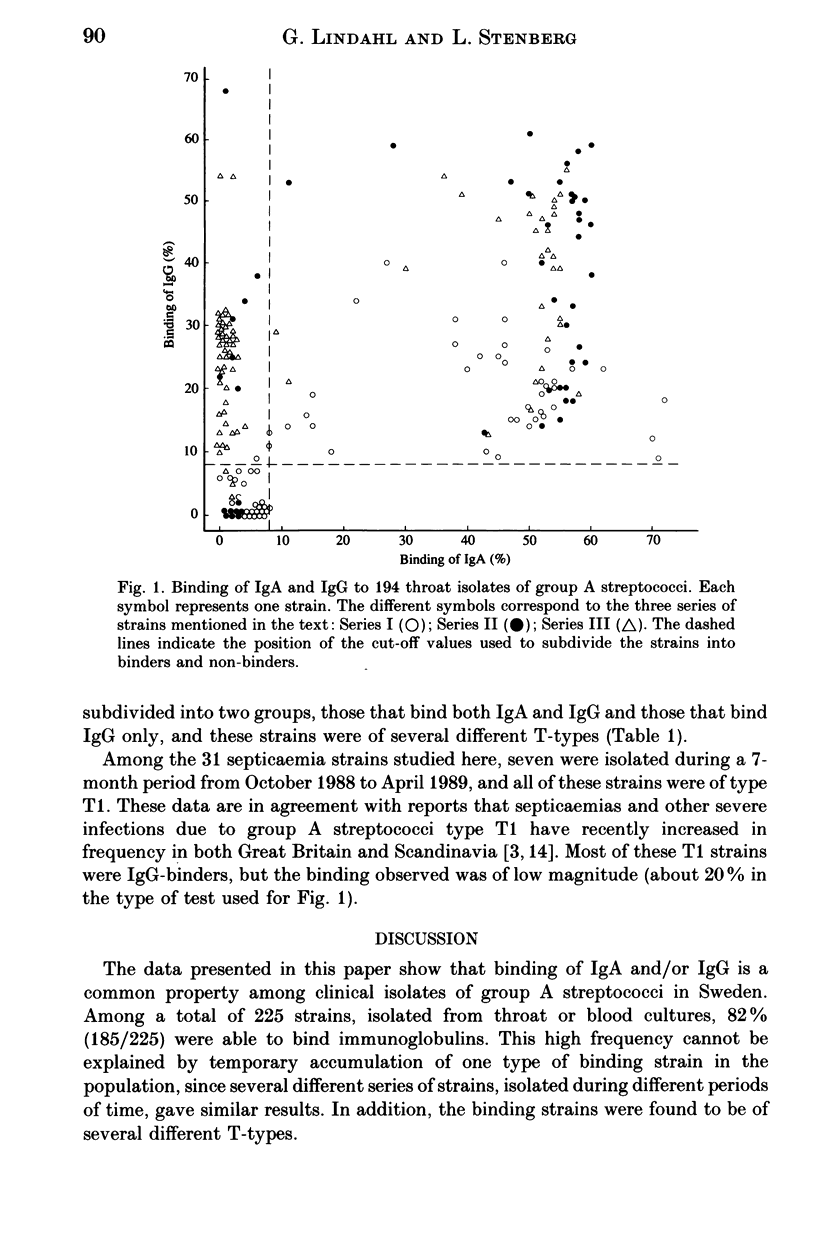Abstract
Certain strains of group A streptococci are known to bind IgA and/or IgG via a cell surface receptor, which may act as a virulence factor. The distribution of such receptors among routine clinical isolates was studied, using a total of 225 strains and an assay based on the binding of radiolabelled immunoglobulins. Among 194 throat strains isolated during three different time periods in two different geographical areas of Sweden, 82% showed significant binding of IgA and/or IgG. Studies on 31 septicaemia strains, isolated over a period of more than 8 years, showed binding for 84% of the isolates. The binding strains were of several different T-types and could be subdivided into two groups, those binding both IgA and IgG and those binding IgG only. These data show that binding of IgA and/or IgG is a very common property among clinical isolates of group A streptococci.
Full text
PDF






Selected References
These references are in PubMed. This may not be the complete list of references from this article.
- Fischetti V. A. Streptococcal M protein: molecular design and biological behavior. Clin Microbiol Rev. 1989 Jul;2(3):285–314. doi: 10.1128/cmr.2.3.285. [DOI] [PMC free article] [PubMed] [Google Scholar]
- Frithz E., Hedén L. O., Lindahl G. Extensive sequence homology between IgA receptor and M proteins in Streptococcus pyogenes. Mol Microbiol. 1989 Aug;3(8):1111–1119. doi: 10.1111/j.1365-2958.1989.tb00261.x. [DOI] [PubMed] [Google Scholar]
- Gaworzewska E., Colman G. Changes in the pattern of infection caused by Streptococcus pyogenes. Epidemiol Infect. 1988 Apr;100(2):257–269. doi: 10.1017/s095026880006739x. [DOI] [PMC free article] [PubMed] [Google Scholar]
- Heath D. G., Cleary P. P. Cloning and expression of the gene for an immunoglobulin G Fc receptor protein from a group A streptococcus. Infect Immun. 1987 May;55(5):1233–1238. doi: 10.1128/iai.55.5.1233-1238.1987. [DOI] [PMC free article] [PubMed] [Google Scholar]
- Kronvall G. A surface component in group A, C, and G streptococci with non-immune reactivity for immunoglobulin G. J Immunol. 1973 Nov;111(5):1401–1406. [PubMed] [Google Scholar]
- Lebrun L., Pillot J., Grangeot-Keros L., Rannou M. T. Detection of human Fc (gamma) receptors on streptococci by indirect immunofluorescence staining: a survey of streptococci freshly isolated from patients. J Clin Microbiol. 1982 Jul;16(1):200–201. doi: 10.1128/jcm.16.1.200-201.1982. [DOI] [PMC free article] [PubMed] [Google Scholar]
- Lindahl G., Akerström B. Receptor for IgA in group A streptococci: cloning of the gene and characterization of the protein expressed in Escherichia coli. Mol Microbiol. 1989 Feb;3(2):239–247. doi: 10.1111/j.1365-2958.1989.tb01813.x. [DOI] [PubMed] [Google Scholar]
- Lindahl G. Cell surface proteins of a group A streptococcus type M4: the IgA receptor and a receptor related to M proteins are coded for by closely linked genes. Mol Gen Genet. 1989 Apr;216(2-3):372–379. doi: 10.1007/BF00334378. [DOI] [PubMed] [Google Scholar]
- Schmidt K. H., Kühnemund O., Köhler W. A screening of streptococci freshly isolated from human and animal sources for binding of human IgG. Zentralbl Bakteriol Mikrobiol Hyg A. 1987 Jul;265(3-4):420–429. doi: 10.1016/s0176-6724(87)80261-4. [DOI] [PubMed] [Google Scholar]
- Stevens D. L., Tanner M. H., Winship J., Swarts R., Ries K. M., Schlievert P. M., Kaplan E. Severe group A streptococcal infections associated with a toxic shock-like syndrome and scarlet fever toxin A. N Engl J Med. 1989 Jul 6;321(1):1–7. doi: 10.1056/NEJM198907063210101. [DOI] [PubMed] [Google Scholar]
- Svensson M., Christensen P., Schalén D. Monoclonal opsonic mouse antibodies specific for streptococcal IgG Fc-receptor. J Med Microbiol. 1986 Nov;22(3):251–256. doi: 10.1099/00222615-22-3-251. [DOI] [PubMed] [Google Scholar]


